T+A - P 3100 HV Preamplifier
Can Dave McNair find love with a high-end, solid-state preamp?
After chatting with the most affable Dave Nauber, CEO of T+A North America, I agreed to review the company’s flagship preamp, the P 3100 HV - fitted with an optional MC phono card. I told him I’m a tube guy and that listening to and writing about a modern, solid-state, German-made preamp from a company I knew almost nothing about was not the first thing that comes to mind when thinking fun review.
Mr. Nauber remained calmly undaunted and said, "I’ll be shocked if you don’t love the sound of it” - or words to that effect.
Boy, howdy, was he ever right.
Yes, We Have No Tubes Today
The P 3100 HV arrived in a substantial-sized wood crate with a built-in pallet. Uh, I thought this was a preamp? Did someone get the order wrong and send a big power amp? Nope. A naked P 3100 HV weighs in at a whopping 61.7 pounds. After unpacking and installing the preamp on a place of honor atop one of my Acora Acoustics black granite equipment racks, I plugged it in and fired it up as I sat back with the owner's manual.
Incidentally, the P 3100 HV requires two power cords that plug in on either end of the rear panel. The double power cords are not for dual-mono internal architecture but to feed separate power supplies to supply the analog circuitry separately from the digital circuits. I remember thinking this was a little tip-off that I was in for some serious listening. Although the only thing digital in the P 3100 HV is the display and volume control logic, separate power supplies are advantageous for components with a mix of digital and analog circuitry. Wouldn’t want the EPA after me for polluting analog circuits with all those toxic, high-speed digital bits flying around.
The T+A HV (HV denotes high voltage) series encompasses several components in a similar form factor. In addition to the preamp reviewed here, the 3100 series includes a DAC, Preamp/Streamer/DAC, CD/SADC Transport, and Integrated amp.
The high voltage designation denotes T+A’s engineers' desire to imbue transistors with some vacuum tube magic.
It turns out that tubes have a pretty wide sweet spot for amplification. It’s not difficult to get a good transfer curve over a broad audio frequency band, and getting good, clean numbers doesn’t take much negative feedback. Some tubes, like the 300B, are linear enough to get away with no global feedback.
It’s a different story with transistors—just the opposite.
However, some transistor types have a wider-than-average sweet spot. Those types of devices are expensive and require a higher voltage rail than is typical. In the P 3100 HV the T+A, engineers supply 100 volts to achieve a tube-like response from the solid state components. To put this into perspective, most hifi gear uses chips (integrated circuits or ICs) designed to work at +/- 16 volts - up to 24 volts in a few designs. When you ramp things up to 100 volt rails, you must use select discrete semiconductors to custom-build operational amplifiers instead of off-the-shelf IC’s.
The chosen circuit topology in the P 3100 HV is fully differential, cascode amplifiers using select, high voltage J-Fets. Niiiice.
Furthermore, the components inside the preamp are contained in various sealed boxes machined from billet aluminum to isolate and, more importantly, temperature control the devices. This careful attention to detail results in no coupling capacitors used to block DC. I don’t know if a DC servo circuit is used or if the chosen devices, bias curve, and temperature control are so good that nothing is needed. Whatever the case, that is impressive engineering.
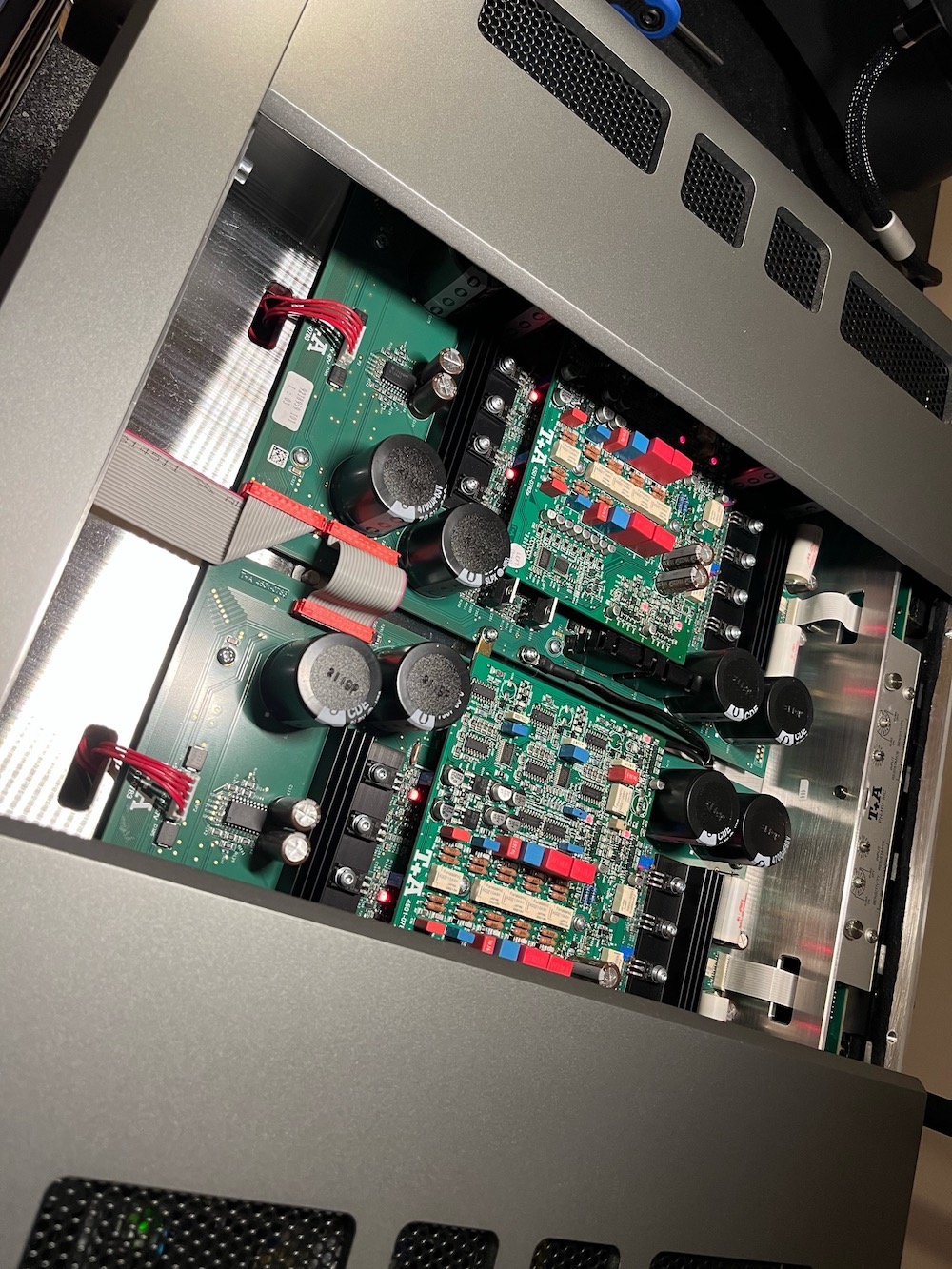
After hearing how all this engineering came together to amplify recorded music in such a captivating manner, it made sense when I found out T+A history started with products such as loudspeakers with electrostatic driver elements powered by vacuum tube amps.
Did I mention enjoying the clicking sound of gold-plated, gas-sealed relays? That’s the sound you hear when changing the volume with the remote or volume knob. And that knob feel - luxurious to the touch as I felt the hint of steps to open and close the relays.
Features
The P 3100 HV front is straightforward, consisting of two large knobs and a readout/touchscreen panel. A very hefty and comprehensive remote is supplied.
Round the back is an entire field of connections, both XLR and RCA. Included are 7 RCA inputs, 4 of which also have a balanced XLR input option. Outputs include a preamp out as RCA or XLR, a headphone output, and a record out. I used the record out to listen to the MC phono stage by running into a line in on my VAC Master Preamplifier.
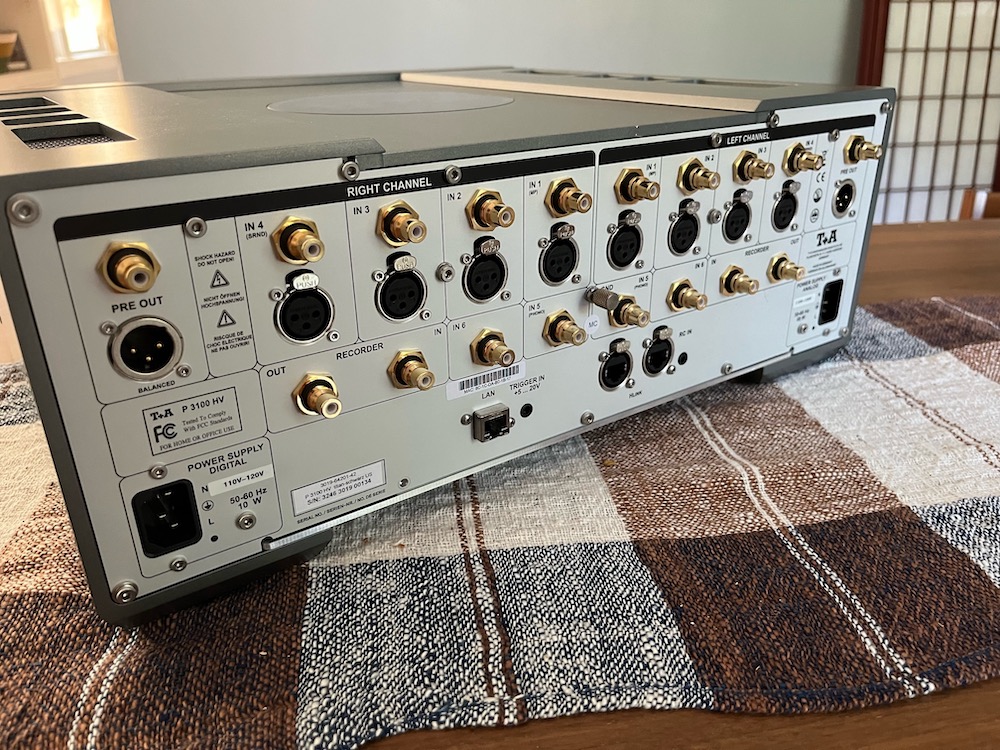
I dutifully read the manual. While I learned a few valuable things about operating the T+A preamp, I can’t say it’s the easiest to glean info from.
The top panel of the P 31000 HV is in two pieces: the metal casework and a removable glass piece ostensibly for viewing those gorgeous innards. The glass piece must be removed to get to the phono card settings. After removing two screws, the glass panel slides out. This sounds easy, but it was not.
Also, I had to search online for the (optional) MC phono module info to determine how to decode the loading and gain settings. These settings are etched on tiny trim pots on a scale of 1 through 10 and A through F. The metal trim pots must be turned with a tiny screwdriver. Also, it was a bit difficult to see how the marking on the knobs corresponds to whatever setting is desired.
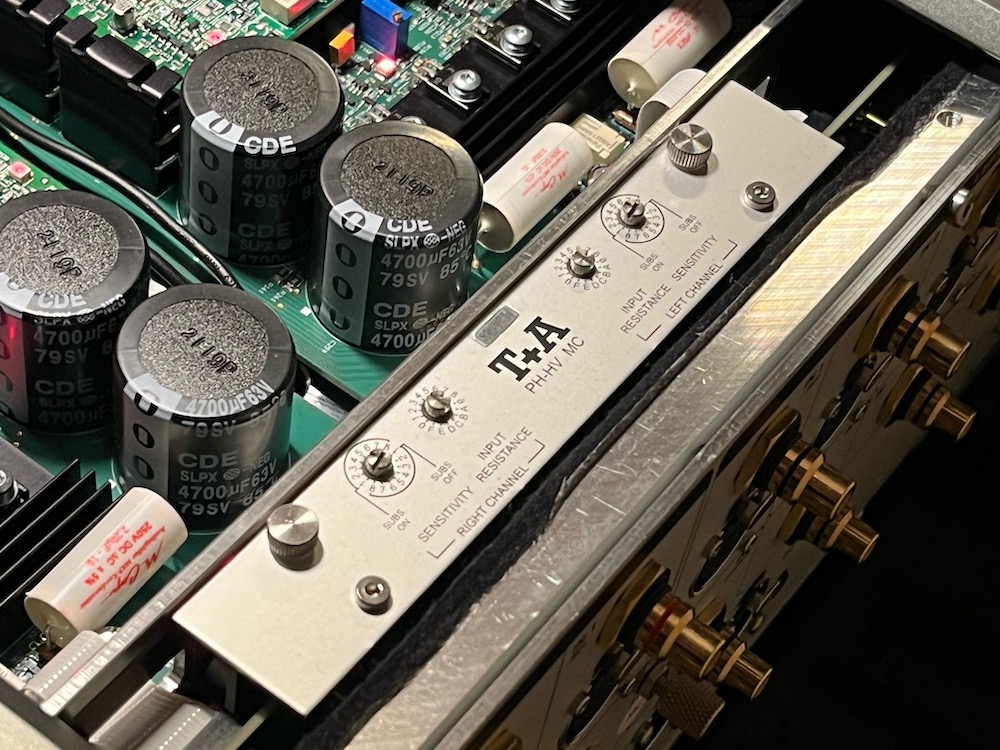
Along with left/right balance, a loudness control (when was the last time you saw that!), and basic tone controls, T+A also gives the user a comprehensive set of equalization for room acoustics correction. There are provisions for using a calibrated measurement microphone, or you can freestyle it. But here’s the thing: it’s analog! No dsp used.
On paper, digital eq is perfect. They said that about CD’s too. Heh.
I have found in my day job that as good as digital equalizers have become, there remains a certain special something, about a well-designed and constructed analog equalizer. Analog eq’s can add character, good or bad. To my ear, the analog eq circuitry in the P 3100 HV sounds fabulous. Users that aren’t afraid to break the taboo of using tone controls will enjoy the sound of the T+A eq. The three bands, complete with parametric frequency selection, did a fine job of dipping an 80hz issue I have with some speakers in my listening room. I also played with adding a tiny bit of energy to the 2-4K area.
All these features can be controlled by an enormous, hefty feeling remote that controls everything, including your listening room temperature, and will fly your drone.
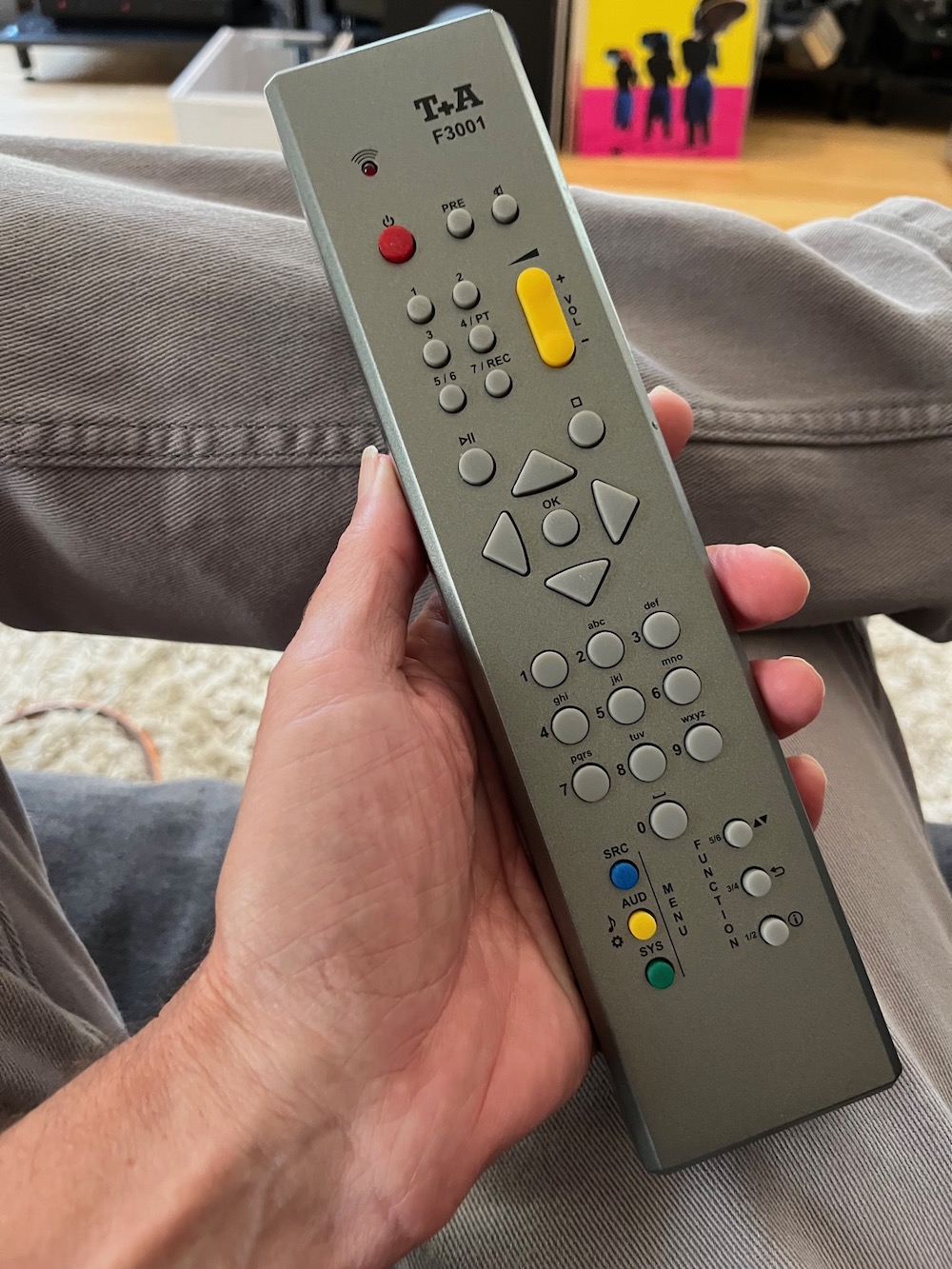
OK, enough talk about eq and bitching about the little things. On to the important stuff, like how does it sound?
The T+A P 3100 HV sounded remarkable in my listening room.
This preamp was as sonically rewarding as I’d ever want for solid-state and close to my reference tube pre.
In Use
Sometimes, with gear designed to be very clean and true-to-source, describing attributes isn’t the easiest thing for me, so I made sure I had a lot of listening time. I also switched back and forth many times between the T+A and my reference VAC Master Preamplifier. The record-out feature of the P 3100 HV came in handy to isolate the sound of the MC phono stage by feeding the record-outs to a line-in on the VAC pre. This way, I could compare apples to apples as far as the two phono sections. However, most of my audition time was spent with the P 3100 HV as a complete preamp that I used to drive my Ampsandsound Zion monos into a pair of Qln Prestige Five loudspeakers.
Maybe T+A’s history of starting with vacuum tube electronics and evolving into an all-solid-state line of electronics is a bit of a giveaway to the level of musicality I heard. Yes, the P 3100 HV is solid state and mucho clean, but never at the expense of that elusive sense of musicality.
The T+A preamp is the first preamp in my memory that, when going back to the VAC after several days of time with the T+A in the system, my ears were not relieved. Yes, the VAC was slightly more fleshed out and dimensional sounding, but I missed some of the clean, transient speed and space between sounds evident with the P 3100 HV.
Over several weeks, I went back and forth to get a sense of what I enjoyed so much about the sound of my system when using the T+A to play tunes.
The T+A was not what I would term fast sounding, but the leading edges of transients were delivered with a seductive sense of right-ness. I heard a clarity on vocal sibilance that removed some of the texture, making the S or T on an over-compressed vocal far less distracting. Furthermore, the increased clarity I heard on vocals and cymbals never felt disconnected or uncoupled from the body of the sound.
Interestingly, I didn’t hear much in the way of additional low-end slam or depth compared to the VAC. Maybe it was a hair tighter, but not night and day.
I did a fair amount of streaming with my Innous Zen Mini feeding a Forssell Technologies MADA-2a DAC, but vinyl sounded so good that it was my preferred source.
I found the optional MC phono card to be much more than an added feature; it was excellent in a way that rivaled other high-end phono stages I’ve experienced
The first thing I noticed was a pronounced lack of noise. I’m talking crazy quiet.
Sometimes, when I read a review about a piece of unusually quiet gear, I roll my eyes and think, Yeah, but what about the ambient noise in your room? C’mon, how quiet does something have to be before it's inconsequential?
Well, in my listening room, which is quiet but by no means mission-critical-quiet, like some rooms I’ve been in, the S/N spec of the T+A phono and line stage was very audible (or should I say in-audible?). I think this must be partly responsible for the alluring space between sounds I heard on many recordings, even on records that were not particularly quiet. I could hear the difference between low-level groove swish and higher frequency tape hiss on very quiet, older analog-sourced records. Dayum.
The sense of detail bourne out of the least amount of extraneous noise coupled with an immaculate transient portrayal (as opposed to a tipped-up treble region) - is a thing of beauty. I had many lengthy and luxurious listening sessions with no listening fatigue. It also allowed me to relax my brain, which is no small feat unconsciously.
During my listening time, I did something I don’t do very often during a review: I played a lot of records that are not what I consider sonic references. I guess this happened because, after a brief initial period of playing recordings that are long-time references, I wanted to get away from listening for a specific thing. The sound of the phono and line stages in the P 3100 HV was so good I simply wanted to enjoy the music.
That meant playing stuff like old Stones records, used ECM purchases like a John Abercrombie Quartet album, and lots of mid-fi world music.
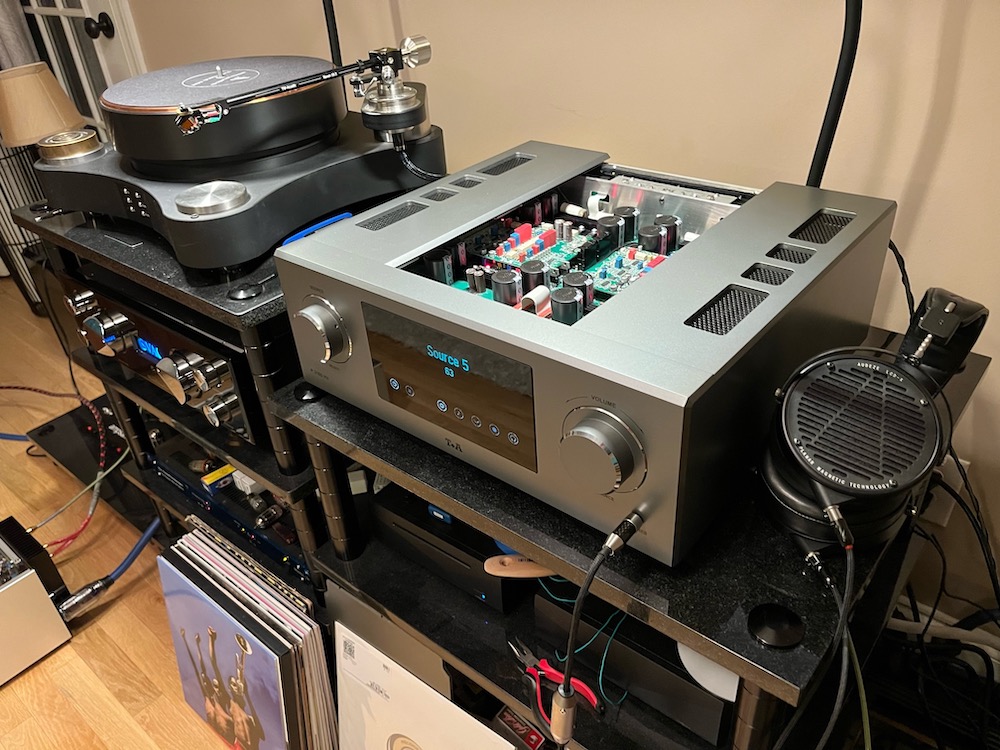
I had many memorable evenings listening to complete albums from start to finish. I could even sit for streaming Pat Metheny’s masterpiece, The Way Up, in its entirety. This never happens for my ADHD-addled noggin, so it’s a pretty solid indication of how enamored I was with the sound of this preamplifier.
One of the things that shocked me was how much more resolution was available from the Ampsandsound Zion Monos. I’ve loved these amps from the moment I heard them, but I was previously unaware of how much detail they are capable of.
I don’t want to give the reader the idea that the VAC sounded syrupy or overly colored like the texture some tube gear exhibits - far from it. I still found the VAC to have a bit more alluring midrange density, sense of depth, and 3D imaging, which I love. But it wasn’t night and day. And the P 3100 HV never sounded dry or antiseptic in its cleanliness. Is the P 3100 HV a solid-state preamp made to satisfy tube lovers? I have no idea, but I’m a tube lover and was satisfied!
I used the RCA outs to drive the amplifiers for most of my listening time. Toward the end, I tried the XLR outputs, which increased the size of the sound.
In the past, I did not prefer the balanced ins on the Zions owing to too much transformer color. Not so when using the T+A.
Towards the end of the review period, I received a pair of Luminous Audio Technology, solid state mono amps - a new offering named Archimedes. Soon, I’ll have a lot more to say about the Luminous amps, but for now, a few observations: The Archimedes amps sound fantastic. Driven by the VAC pre/phono was magical. I also thought the sound of my system was excellent, when putting the T+A preamp in the drivers seat, but I had some of that ole solid state feeling. Clean and tasty sounding, but a little too clean. I enjoyed the P 3100 HV more when there was some tubes somewhere in the signal path.
Finally, I used my Audeze LCD-X and Sennheiser HD-650 to assess the headphone amp - solid and satisfying sounding, with plenty of current to move those high impedance headphone drivers.
Conclusion
As I usually do, I wondered who the customer might be for this beast of German engineering.
I think the P 3100 HV preamplifier will appeal to audiophiles who want a great-sounding preamplifier, but especially to those who don’t want to sacrifice a lot of cool features for summit-level sonics. You get an awful lot for $24,500 (optional phono $1,700).
I’ve heard cassettes are coming back. Reel-to-reel tape has undoubtedly made a splash in recent years. A separate record-out and monitor-in is a recipe for good times making mix tapes. Wanna eq those headphones a bit for late-night listening? Do you have a lot of source gear with a variety of connections? Do you have a prominent room acoustics issue you’d like to correct when using digital and analog sources? Want to enter or upgrade your vinyl playback but don’t feel like adding a big-ticket phono pre to the budget?
The P 3100 HV does all this and more while acting as the high-resolution/high-musicality heart of an audiophile system.
Highly recommended.
Associated gear:
TW Acustic Raven LS turntable, Raven 10.5 tonearm, Dynavector XV-1t cartridge, Wally Tools cartridge and tonearm alignment tools.
VAC Master Preamplifier, Ampsandsound Zion Monos power amps,
Innuos Zen Mini streamer, Forssell Technologies MADA-2a converter
QLN Prestige Five loudspeakers, Acora Acoustics black granite equipment stands, Iconoclast, Cardas,and Furutech cables.
Specifications
Preamplifier stage
Frequency response + 0 / – 3 dB
0,5 Hz – 300 kHz
Signal / noise ratio
108 / 112 dB
Total harmonic distortion
< 0,001%
Intermodulation
< 0,001 %
Channel separation
> 108 dB
Unbalanced inputs (RCA)
7 x 250 mVeff ... 9 Veff / 20 kOhms
Balanced inputs (XLR)
4 x 500 mVeff ... 18 Veff / 5 kOhms
Outputs
Headphones
50 Ohms high current
1 x Recorder
250 mVeff / 100 Ohms
PRE out RCA
Nom 1 Veff, Max 9,5 Veff / 50 Ohms
PRE out XLR
Nom 1,45 Veff, Max 19,6 Veff / 50 Ohms
Reservoir capacity
75000 μF
Mains / Accessories / Dimensions
Mains
2 x 110 - 120 V/60 Hz or 220 - 240 V/50 Hz,
10 + 60 Watts rated current consumption
Standbybetrieb
< 0,5 W
Features
Trigger input +5 ... 20 V for external switching-on
input 4 can be configured in surround mode
analogue signal processing module
slot for optional phono content_default MM / MC
Remote control
F 3001
Accessories
2 x power cord, remote control receiver E 2000
Dimensions (H x W x D)
17 x 46 x 46 cm
Weight
28 kg / 61.7 lbs
Finishes
case: silver laquer 47 or titanium laquer 64
Manufacturer Information
T+A elektroakustik GmbH & Co. KG
Planckstraße 9-11
D-32052 Herford
T +49 (0) 5221-7676-0
F +49 (0) 5221-7676-76


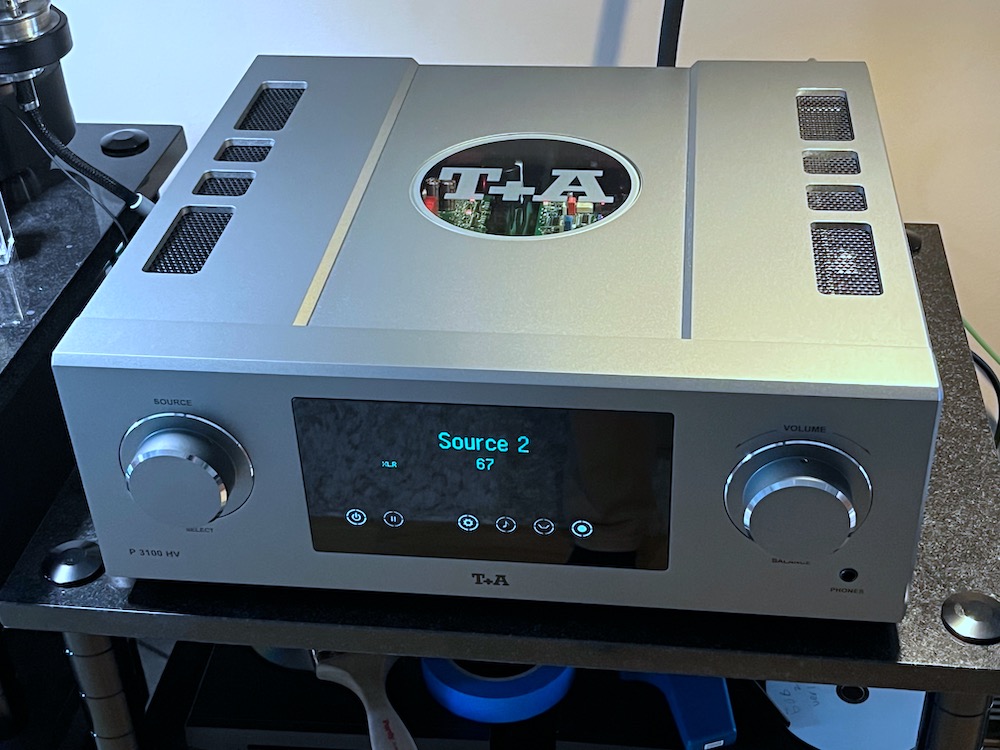







































.png)








